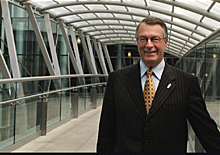 Bellevue developer Kemper Freeman has resigned from the Bellevue Downtown Association.
Bellevue developer Kemper Freeman has resigned from the Bellevue Downtown Association.
Freeman, who owns Lincoln Square, Bellevue Square, and Bellevue Place, had been a member of the Bellevue Downtown Association for more than 30 years – his father was one of the group’s founders – but he strongly disagreed with the nonprofit’s endorsement of the proposed East Link light rail, according to an article in The Seattle Times.
Freeman has hired experts to do his own traffic analysis regarding light rail. The article states that he favors saving tax dollars with freeway expansion and increased bus transit. However, Freeman said his resignation was not a “campaign of any kind or a personal vendetta,” but rather a “lack of alignment of interests” with the board.
Greg Johnson, chairman of the Bellevue Downtown Association board of directors, said the voters decided light rail should come to Bellevue, and the association has endorsed it, according to The Seattle Times.













Uh-oh!
Isn’t Kemper THE Bellevue Downtown Association? Without him, who’s still on it? I know he has business interests, but considering how well his properties are doing vs. The Bravern, I’d tend to go with what Kemper thinks is a good idea. What’s good for core business is good for DT Bellevue as a whole. The tax dollars from businesses has to come from somewhere otherwise citizens are left paying the whole bill for such things as transit.
Of ocurse, let’s not forget that while Kemper dislikes light rail for the unwashed public, he does love his private helicopter on a Bellevue Way roof for rich people.
GOod riddance.
@Henry – The Bellevue Downtown Association has over 40 Board Members (see here: http://www.bellevuedowntown.org/about/board.html), all representing diverse companies and backgrounds (Microsoft, Puget Sound Energy, PACCAR Inc., Symetra Financial, Beacon Capital, Overlake Hospital, Davis Wright Tremaine, Bank of America, CH2M HILL, Wallace Properties, Su Development among them). Each has a stake in Downtown Bellevue and a strong interest in seeing the community thrive. Property developers, like Freeman, are also still well represented on the Board. The BDA Board embodies the ever-evolving community Downtown Bellevue is today. In addition to Kemper Freeman, there are many more players in town that are strongly committed to the success of the city.
Typo! Here is the correct url for the BDA Board of Directors: http://www.bellevuedowntown.org/about/index.html
Light rail only really works in densely populated areas like Europe, Japan, and in the USA, New York City. Washington State just does not have the population or infrastructure to support light rail period…and the cost would be astronomical. And our tax dollars would pay for something that would not bring back profits. Just look at how empty the light rail to Sea-Tac airport is to get an idea. Kemper Freeman is right on this.
I agree completely with Chris. King County doesn’t (especially the eastside) doesn’t have the requisite density to support light rail. I could see the argument for a non-stop, EXPRESS (no stops) triangular light rail system between Seatac, downtown Bellevue, and downtown Seattle, but that’s nothing like any of the current plans.
Artificial density can be created with park and rides (which we’ve done with buses), but that’s not the plan. For the record, I commute from Bellevue to Seattle daily by bus now, so I am PRO Mass Transit, just ANTI Light Rail.
Buses are cheaper and more flexible. Yes, they can be subject to traffic, but commuter lanes (or BUS ONLY) lanes can make that objection moot.
And for those who want to see the future, Light Rail takes longer to get from downtown Seattle to Seatac Airport than the 194 Express used to AND it costs more to ride. Metro/Sound Transit had to kill the 194 bus route because light rail couldn’t compete with it.
I’ll keep my tax money and pass on light rail (that isn’t even scheduled to reach Bellevue for another 20 years).
I just don’t see a Light Rail being any more efficient than the buses we already have here. I’ve spent some time commuting into Seattle and back on the 550 bus, and aside from the buses on the evening commute being full occasionally, it seems to work reasonably well, and the existing I-90 express lanes bypass a lot of the major traffic issues getting across the bridges and Mercer Island. Light Rail seems mostly like an excuse for bureaucrats to spend a bunch of other people’s money.
Kemper general wants the best for the east side and Bellevue. People seem to think that if people have money, that must mean something evil, but it could also mean hard work and good management. Don’t worry about the helicopter pad, worry about how much Boeing got out of the state for the 787 and it still not producing or flying yet!!!! Now that’s tax dollars or lack of, at wa$te…..
Kemper DOES want what is BEST for Bellevue and anybody that doesn’t know that is not actively involved with the Bellevue community.
Having said that, this is why I am disappointed that he has stepped down from the Board at the Bellevue Downtown Association. He is a leader in this community and even if he disagrees with some of the direction I would like to see him use this the board as forum to communicate his ideas.
Light rail haters miss the point – the system is coming, it was approved by voters. Bellevue can either connect to the regional system, thrive in the process, or let it skip us (which is Kemper’s preference), and wither as a result. The Downtown Bellevue Association is smart to embrace this huge investment, because it’s what’s best for all of downtown, even Bellevue Square. Any developer in the world would kill to have light rail come to their property, because it enhances property values – it’s a mystery why Freeman opposes it – simply does not make any sense. Living downtown, I’m all for it. Now peole should be talking about how to make it work – how to deal with construction impacts, how to make it visible and accessible and easy to use. Let’s get over the old fight about whether it should come or not – it’s coming.
The main problem with light rail is that it is funded by the city and paid for with our tax dollars. Not only do we have to pay for the construction costs. But to keep the light rail operating/maintenance is very costly. How will it pay for itself in this state? We have a population of 7 million people. The United Kingdom has 62 million and Japan 128 million. Not only that but we have great roads for cars/buses. And gas prices are much cheaper here than the UK or Japan. So what is really the incentive to get people to take the light rail when we have so much more freedom in our cars. Kemper Freeman is an intelligent businessman , but it does not take someone with his intelligence to understand that financially we will be in the hole not only now but in the future as well with the City’s light rail plans.
To Bruce,
You may want to consider checking your comments before posting misleading information like that. The 194 was a Sea-Tac to Downtown express via I-5 and the E-3 busway, pretty much only serving downtown. Link light rail, however, serves downtown, SODO, Beacon Hill, the Rainier Valley, and Tukwila-Hwy 99. The travel time differential a couple of minutes, more or less. So no, Metro/ST did not kill the 194 because light rail couldn’t compete with it. It’s the other way around.
There’s some to be some stunted short-term thinking on your part. Buses are cheaper because they aren’t capital-intensive, but end up being far more expensive to run in the long-term because of limited capacity, the subsequent need for more drivers (where labor is the driving factor behind operating costs), shorter lifespans, and higher fuel/maintenance costs. Plus, you may also factor in loss of economic productivity when buses get stuck in surface traffic and other externalities like diesel emissions.
And to Chris and Bruce, this ‘density as a requisite’ mantra is just an empty talking point. True, there are density thresholds that make transit more useful, however, there is a large gray area in which your density is too high for automobiles and buses, but supposedly too low for trains. We are seeing this in downtown Bellevue– there is not enough transportation capacity to avoid congestion, not enough layover capacity for street-bound buses, so how are people supposed to get in and out of downtown without being stuck in traffic?
Think outside of your own pockets for once. A marginal tax increase won’t kill you. And without rail, once Bellevue does get to higher densities, it will be our kids who will pay the brunt of consequences from our poor planning decisions.
Every light rail that has been introduced on the west coast has been a failure. The list includes LA, Las Vegas, and San Jose. Here is a link on the failure of LA’s light rail, http://ti.org/antiplanner/?p=3494. And recently, Las Vegas has a monorail transit system that filed for bankruptcy protection and could force Nevada taxpayers to pay higher interest rates on money that the state borrowed through bond financing, an attorney for a major creditor in the bankruptcy case warned. And the Las Vegas strip must have horrific traffic, yet people are not supporting their monorail system. Why should we follow in the footsteps of failure. Why are we so light rail envy? The problem is that light rail is not a private business, so when it fails it does not shut down and go away. We, the taxpayers will have to pay for it. And if it is not making money, we will be forced to pay for it and our future generations as well. The LA light rail was introduced in the mid 1980’s. Presently, the amount of riders has not increased since it was introduced. That should be a red flag for us not to follow in California’s footstep. Why can’t we learn from the mistakes of other states on the west coast?
Just a note on Link, once north Link opens there will be no complaining of Link’s ridership… central link being opened first was a big mistake IMHO.
Oh and to all the people pining for the 194, they must have never actually ridden it: it was cramped, often packed, late, and often stuck in I5 traffic for along time.
A note to Chris – if you’re so knowledgeable about the topic, how is it you think the light rail system is funded by the city and paid for by our tax dollars. Sheesh – do just a little homework, and you’ll discover Sound Transit is the agency, they operate in three counties, and they fund the system with a total of 7/10 of a cent of sales tax collected in the three-county area. The City of Bellevue contributes nothing (directly) into the system. Yet you’re an expert on the topic. And every west coast light rail system has failed? Excuse me?
I will miss Kemper and thought I was going to read about all of the wonderful things our citizens of Bellevue would say about him in this blog. I didn’t realize it was a heated debate about the light rail. I’ve lived in Bellevue since 1982. I’ve seen Mr Freeman shape this community to make it what it is today. he needs to take a bow for that. I just have one question for every one of you who has an opinion on the Light Rail matter. How many of you attended the Town Hall at Bellevue City Hall and voiced your concerns. I did! To four of them actually in the past 2 years. Not much of a turn out by the community if I may say so. Sound Transit had already made its’ decision on the proposed route before they even announced it. Bellevue has been and will continue to be divided on where the route should have been and if we should even have light rail in Bellevue. I am personally for it, but I do not agree with the route they chose or how they went about it. I think the whole thing could have been handled better.